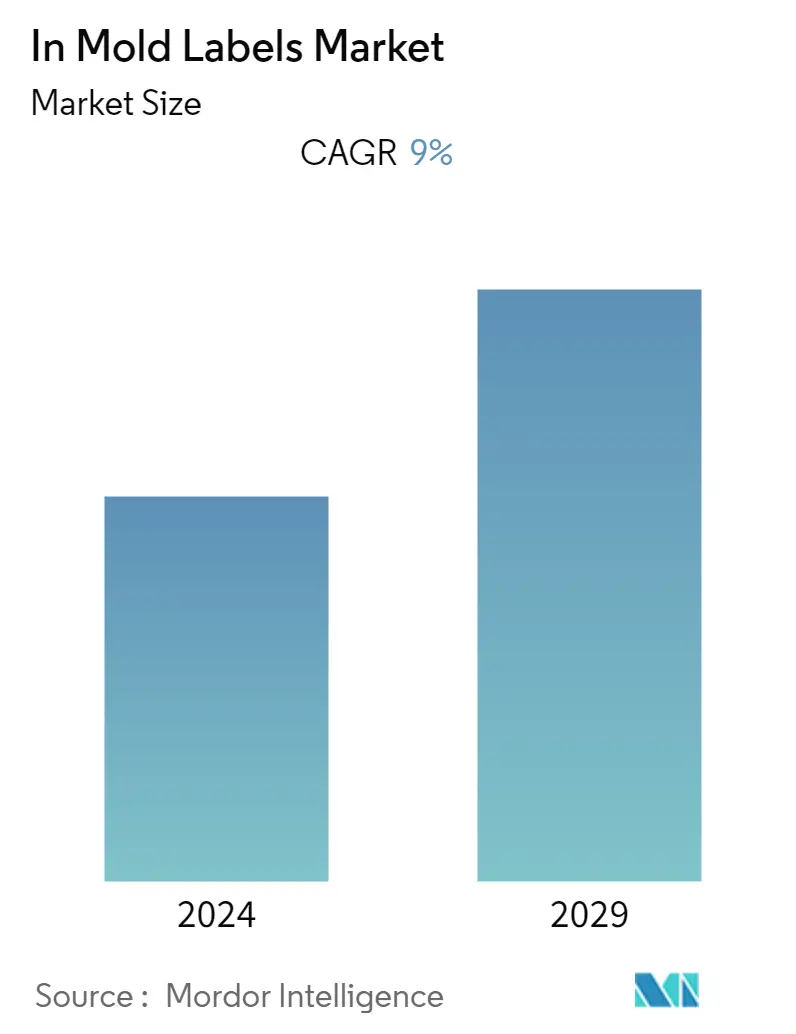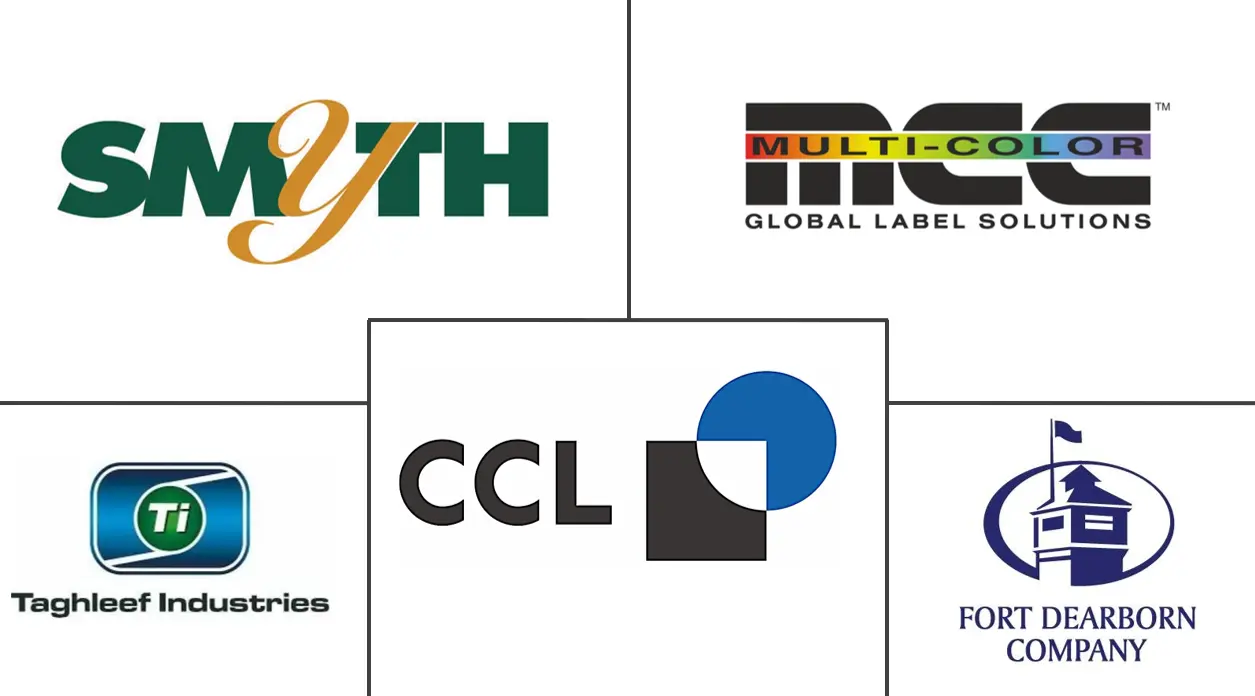Market Size of In Mold Labels Industry

| Study Period | 2019 - 2029 |
| Base Year For Estimation | 2023 |
| CAGR | 9.00 % |
| Fastest Growing Market | Asia Pacific |
| Largest Market | North America |
| Market Concentration | Low |
Major Players
*Disclaimer: Major Players sorted in no particular order |
In-Mold Labels Market Analysis
The in-mold labeling labels market is expected to register a CAGR of 9% by the end of the forecast period 2021-2026. These labels serve as an integral part of the final product that is delivered as a pre-decorated item. The COVID-19 pandemic disrupted the supply chain for the industry.
- The in-mold labeling provides the user with higher decorating options than other methods. The labels are strong and durable and can withstand both rough handlings, shipment-induced scuffing, provide Maximum print quality, Wide range of look & feel options, enables Quick design changeovers, Shorter production time and lower production costs, are Strong and hygienic, and Environmentally-friendly.
- The players in the industry, owing to the advantages offered by it, are increasingly looking forward to adopting IMLs. P&G partnered with Multi-Color Corporation to incorporate a more premium look and feel in their laundry packaging for a better shelf presence. MCC, to deliver a cold foil in-mold label to P&G, transitioned the large volumes of labels across all print technologies, including their entire liquid laundry portfolio and delivered on the desired design intent,.
- In September 2019, Cosmo Films launched a high tear-resistant synthetic paper, polypropylene films for repositionable and removable label applications, matte coated pressure-sensitive label stock films, transparent in-mold label film, high-speed WAL film, and pearlized metalized WAL film. Such instances are indicative of the fact that the in-mold label market is expected to grow over the forecast period.
- Moreover, companies are also investing in in-mold labeling systems that enable them to shorten production time and achieve higher print quality. For instance, in January 2020, announced that it received an order from a Brazilian plastic manufacturer for a robotic system of In-Mold Labeling (IML) system.
In-Mold Labels Industry Segmentation
In-mold labels are formed by fusing high-quality graphic images on plastic containers through processes such as injection molding, blow molding, and thermoforming. The report segments the market by End-user Industry (Pharmaceutical, Food & Beverage, Cosmetics), and Geography.
| By End-User Industries | |
| Food & Beverage | |
| Cosmetics | |
| Pharmaceuticals | |
| Other End-user Industries |
| Geography | |
| North America | |
| Europe | |
| Asia Pacific | |
| Latin America | |
| Middle East and Africa |
In Mold Labels Market Size Summary
The in-mold labels market is poised for significant growth, driven by its advantages over traditional labeling methods. These labels offer enhanced durability, superior print quality, and a wide range of aesthetic options, making them increasingly popular among industry players. The market has seen disruptions due to the COVID-19 pandemic, but it is expected to recover and expand, with companies like P&G and Multi-Color Corporation leading the charge in adopting in-mold labeling for improved packaging aesthetics. Innovations such as Cosmo Films' high tear-resistant synthetic paper and robotic IML systems further underscore the market's potential. The food and beverage sector is anticipated to be a major adopter, given the labels' ability to extend product shelf life and reduce waste, particularly in frozen food packaging.
The competitive landscape of the in-mold labels market is fragmented, with key players like CCL Industries and Multi-Color Corporation investing in capacity expansion and technological advancements to strengthen their market presence. The demand for customizable and premium labels is on the rise, fueled by increasing disposable incomes and a shift towards innovative packaging solutions. Companies are expanding their production capabilities and entering new markets to capitalize on this trend. Notable developments include CCL Industries' investment in a new co-extrusion line in Poland and Huhtamaki's establishment of a fiber packaging plant in Russia. These strategic moves are expected to drive market growth and enhance the competitive dynamics in the coming years.
In Mold Labels Market Size - Table of Contents
-
1. MARKET DYNAMICS
-
1.1 Market Overview
-
1.2 Industry Value Chain Analysis
-
1.3 Industry Attractiveness - Porter's Five Force Analysis
-
1.3.1 Threat of New Entrants
-
1.3.2 Bargaining Power of Buyers/Consumers
-
1.3.3 Bargaining Power of Suppliers
-
1.3.4 Threat of Substitute Products
-
1.3.5 Intensity of Competitive Rivalry
-
-
1.4 Impact of COVID-19 on the Market
-
1.5 Market Drivers
-
1.5.1 Growing Demand for Appealing and Good Asthetics
-
1.5.2 The rising Need to Withstand Temperature Fluctuations
-
1.5.3 Increased Consumption of Frozen Containerized Foods
-
-
1.6 Market Restraints
-
1.6.1 Tedious Mold Production Process
-
1.6.2 Interoperability Issues
-
-
-
2. MARKET SEGMENTATION
-
2.1 By End-User Industries
-
2.1.1 Food & Beverage
-
2.1.2 Cosmetics
-
2.1.3 Pharmaceuticals
-
2.1.4 Other End-user Industries
-
-
2.2 Geography
-
2.2.1 North America
-
2.2.2 Europe
-
2.2.3 Asia Pacific
-
2.2.4 Latin America
-
2.2.5 Middle East and Africa
-
-
In Mold Labels Market Size FAQs
What is the current In Mold Labels Market size?
The In Mold Labels Market is projected to register a CAGR of 9% during the forecast period (2024-2029)
Who are the key players in In Mold Labels Market?
CCL Industries., Multi-Color Corporation, Smyth Companies, LLC, Taghleef Industries Inc. and Fort Dearborn Company are the major companies operating in the In Mold Labels Market.

